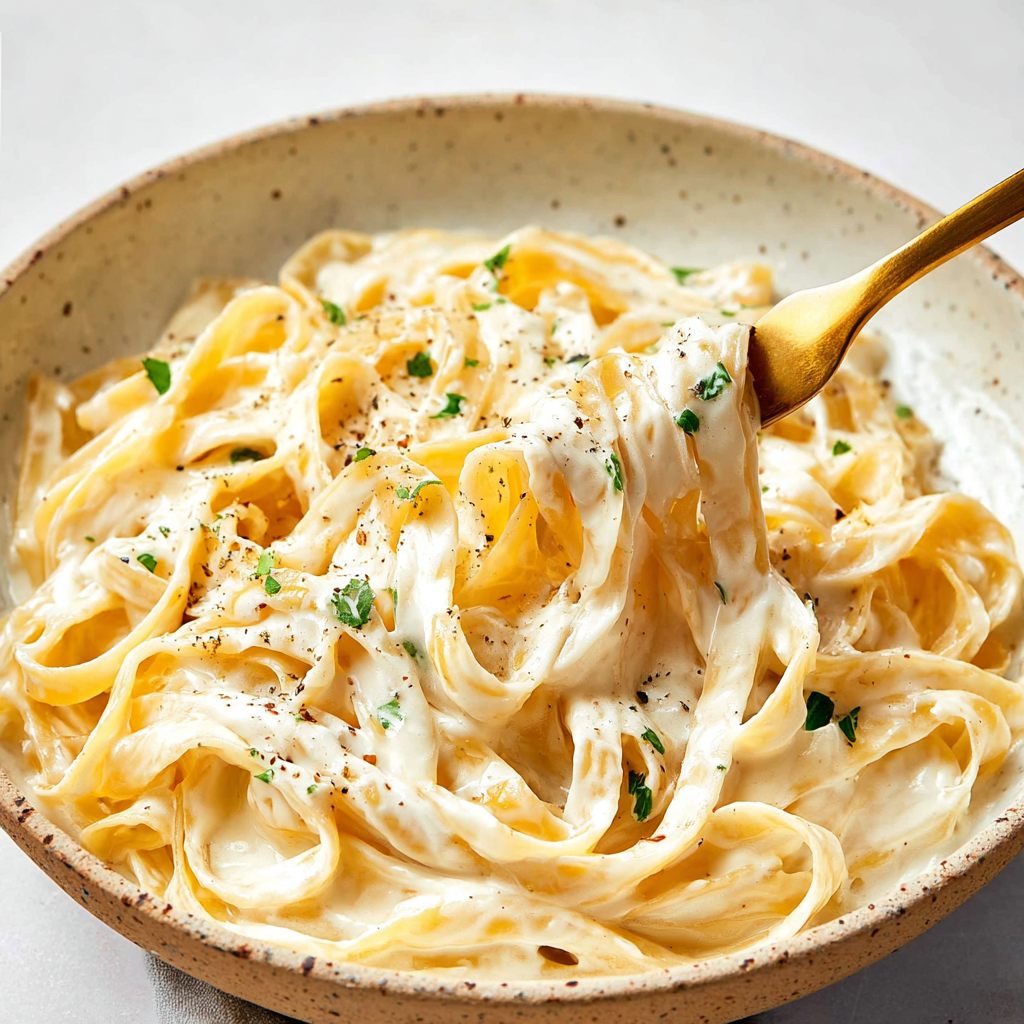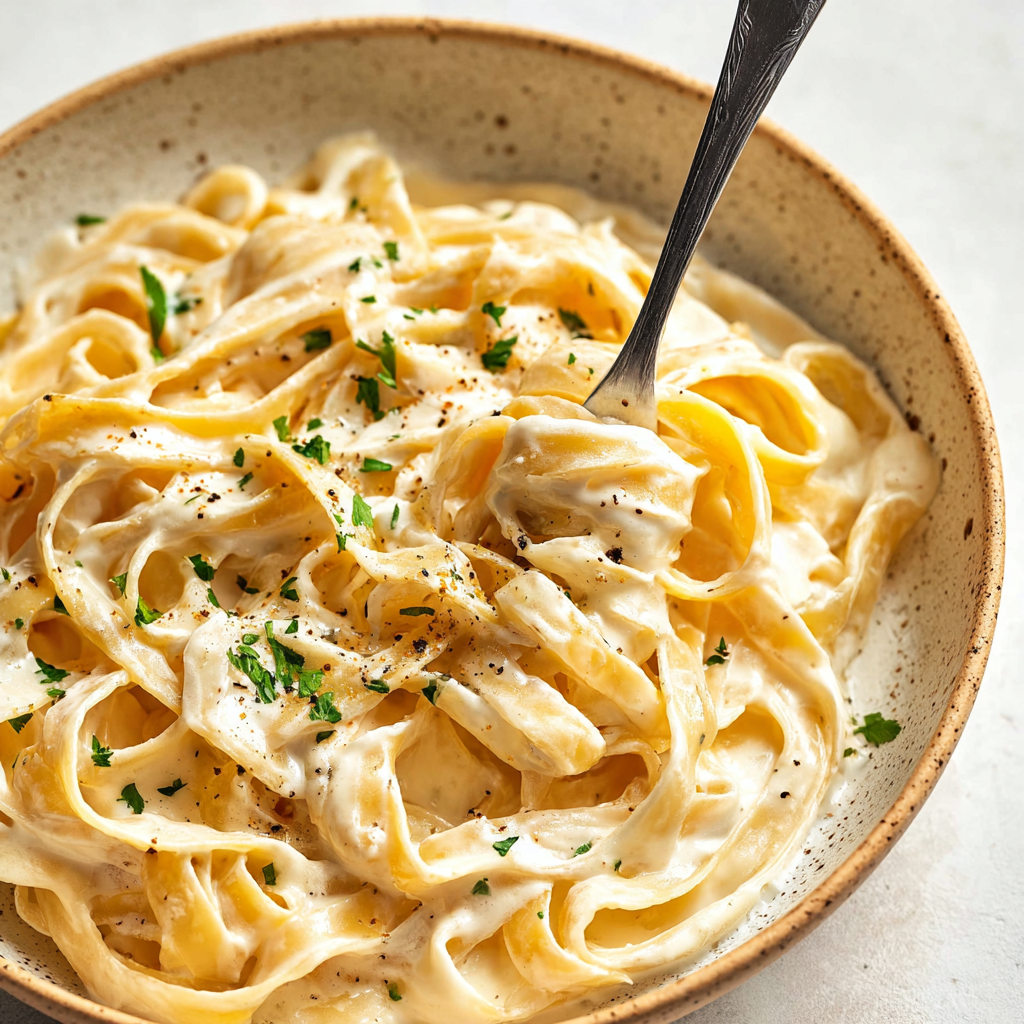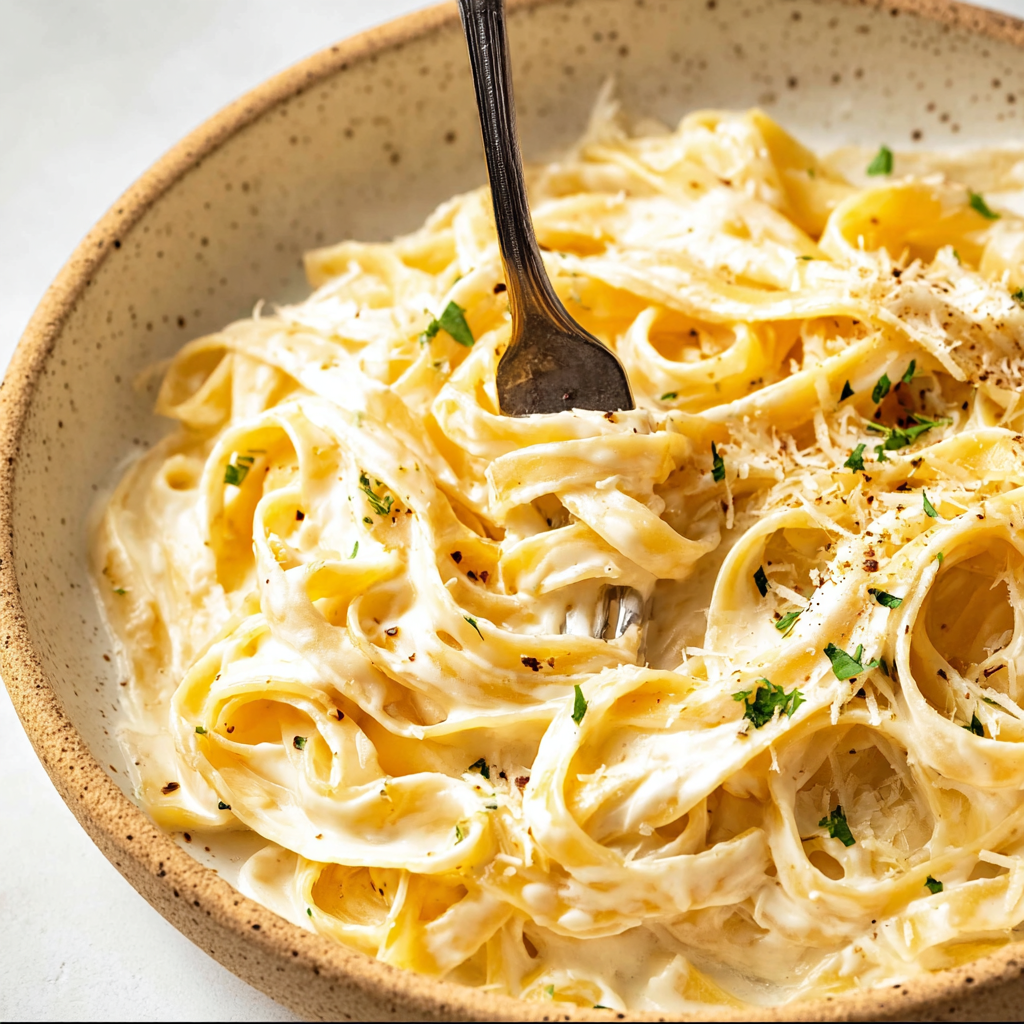1. Introduction to the Recipe
If you’re craving something comforting, indulgent, and easy to make, this Easy Homemade Alfredo Sauce is your go-to recipe. Forget jarred sauces loaded with preservatives—this sauce comes together in about 20 minutes using simple pantry ingredients and tastes like it came straight from a restaurant kitchen.
Unlike traditional Alfredo which relies on just butter, Parmesan, and cream, this version adds cream cheese and flour for a thicker, more stable sauce that clings to pasta beautifully. The cream cheese gives it an ultra-creamy texture and a slight tang that balances out the richness, while fresh garlic and Parmesan cheese build that signature flavor profile we all love.
Whether you’re tossing it with fettuccine, pouring it over grilled chicken, or using it as a base for white pizza, this Alfredo sauce delivers. It’s flexible, beginner-friendly, and completely crave-worthy.
Need to sharpen your sauce skills? Check out this guide to making roux-based sauces or tips for melting cheese smoothly.
Let’s dive into cheesy comfort.
2. Basic Recipe: Ingredients and Instructions
Print
Easy Homemade Alfredo Sauce – Creamy, Rich & Foolproof
Description
This Easy Homemade Alfredo Sauce is rich, creamy, and made with real ingredients. Perfect over pasta for a quick, satisfying dinner.
Ingredients
- 1 (8 oz) block cream cheese – do not use reduced fat
- 4 cups milk (2%, whole, or 1% preferred)
- 4 heaping tablespoons all-purpose flour
- 2 teaspoons garlic powder
- 2 teaspoons kosher/coarse salt (not table salt)
- 2 tablespoons butter
- 4 garlic cloves, minced (or 2 teaspoons jarred minced garlic)
- 1 1/2 cups freshly grated Parmesan cheese
- Pasta of your choice, cooked and drained
Instructions
- Prep the ingredients:
- Set out cream cheese to soften to room temperature.
- Cook pasta according to package instructions and set aside.
- Create the roux base:
- In a large saucepan or skillet, melt the butter over medium heat.
- Add minced garlic and sauté for 1–2 minutes until fragrant but not browned.
- Sprinkle in the flour and whisk continuously for about 1 minute until a thick paste forms.
- Add milk gradually:
- Slowly pour in the milk, about 1 cup at a time, whisking constantly to prevent lumps.
- Continue whisking until the mixture starts to thicken and bubbles gently.
- Add cream cheese:
- Cube the cream cheese and add to the pan, whisking until fully melted and incorporated.
- Season and finish:
- Stir in garlic powder, salt, and freshly grated Parmesan cheese.
- Lower heat and stir until cheese is melted and sauce is smooth.
- Toss and serve:
- Pour sauce over cooked pasta and toss to combine.
- Garnish with extra Parmesan or chopped parsley if desired.
Notes
Freshly grated Parmesan melts better and avoids graininess.
Don’t use low-fat cream cheese—it won’t melt properly and will change the sauce texture.
The sauce will thicken further as it cools.
3. Advanced Techniques
Use Warm Milk for a Smoother Sauce
Warming the milk slightly before adding it to the roux helps it blend faster and prevents lumps. Cold milk can cause the mixture to seize and delay thickening.
Grate Parmesan by Hand
Pre-shredded Parmesan often contains anti-caking agents that prevent it from melting smoothly. Hand-grated cheese from a block creates a silkier sauce with better flavor.
Finish With a Touch of Nutmeg
A pinch of freshly grated nutmeg added at the end complements the creaminess and adds a subtle warmth that enhances the savory notes of the cheese.
Infuse the Butter With Herbs
Before adding the garlic, infuse the butter with a sprig of rosemary or a few sage leaves for added depth. Remove the herbs before proceeding with the roux.
Make It a Protein-Packed Meal
Stir in cooked, chopped grilled chicken, shrimp, or pancetta just before serving for a full one-pan meal. Be sure the protein is well-seasoned to avoid a bland result.

4. Storage, Shelf Life, and Maintenance Tips
Refrigeration
Store leftover Alfredo sauce in an airtight container in the fridge for up to 4 days. Reheat slowly in a pan with a splash of milk to loosen the texture.
Freezing Instructions
Cream-based sauces can separate after freezing, but this recipe holds up relatively well thanks to the flour. Let cool, then store in a freezer-safe container for up to 1 month. Thaw in the fridge before reheating gently.
Reheating Tips
Reheat over low heat, stirring frequently. Add a splash of milk or cream to restore the original creaminess. Avoid microwaving if possible, as it can make the sauce separate.
Avoid Grainy Texture
To prevent the sauce from becoming grainy, avoid boiling after adding the cheese. Low, slow heat is key for a smooth, creamy finish.
Store Pasta and Sauce Separately
If possible, store cooked pasta and Alfredo sauce separately to prevent soggy noodles. Combine just before serving.

5. Dietary Adaptations and Substitutions
Gluten-Free Version
Use a gluten-free flour blend to make the roux. Make sure your pasta is also certified gluten-free. The texture and taste remain nearly identical.
Low-Fat Option
Substitute whole milk with 2% milk and reduce the butter slightly. Use Neufchâtel cheese instead of full-fat cream cheese. The sauce will be lighter but still flavorful.
Dairy-Free Alfredo Sauce
Swap cream cheese and milk with plant-based alternatives (such as oat milk and dairy-free cream cheese). Use nutritional yeast or vegan Parmesan for cheesy flavor.
Low-Sodium Adaptation
Reduce the salt and use unsalted butter and low-sodium Parmesan cheese. Adjust seasoning to taste at the end.
Add Vegetables for Nutrient Boost
Add cooked spinach, peas, mushrooms, or steamed broccoli into the sauce before serving. They add texture, flavor, and a bit of nutrition without changing the base recipe.

6. FAQs About the Recipe
Can I make this sauce ahead of time?
Yes! You can make the sauce 1–2 days ahead and refrigerate it. Reheat slowly over low heat with a splash of milk to bring back the creamy texture.
Why is my Alfredo sauce lumpy?
Lumps usually form when cold milk is added too quickly to a hot roux. To fix this, whisk vigorously or strain the sauce through a sieve before serving.
What pasta works best with Alfredo?
Fettuccine is the classic choice, but this sauce pairs beautifully with penne, rotini, linguine, or even stuffed pastas like tortellini.
Is Alfredo sauce the same as white sauce (béchamel)?
Not exactly. Alfredo typically includes cheese and cream, while béchamel is a basic roux with milk and no cheese. Alfredo is richer and more indulgent.
Can I use pre-shredded Parmesan cheese?
You can, but it may not melt as smoothly. Freshly grated Parmesan melts more evenly and adds better flavor.
Can I double the recipe?
Absolutely! Just keep the ratio of ingredients the same. Make sure you use a large enough saucepan to avoid boiling over.

7. Conclusion & Final Thoughts
This Easy Homemade Alfredo Sauce recipe is proof that comfort food doesn’t have to be complicated. With just a few ingredients and less than half an hour, you can create a rich, creamy sauce that transforms any pasta dish into something special.
Whether you’re serving it on a busy weeknight or indulging in a weekend dinner, this sauce checks every box—it’s thick, cheesy, and full of garlicky flavor. Plus, it’s endlessly customizable. Add chicken, toss in some veggies, or use it as a base for your favorite pasta bakes.
Homemade Alfredo beats the jarred stuff every time, and once you try this recipe, you’ll never look back. Keep this one in your back pocket—it’s a guaranteed crowd-pleaser, every single time.
